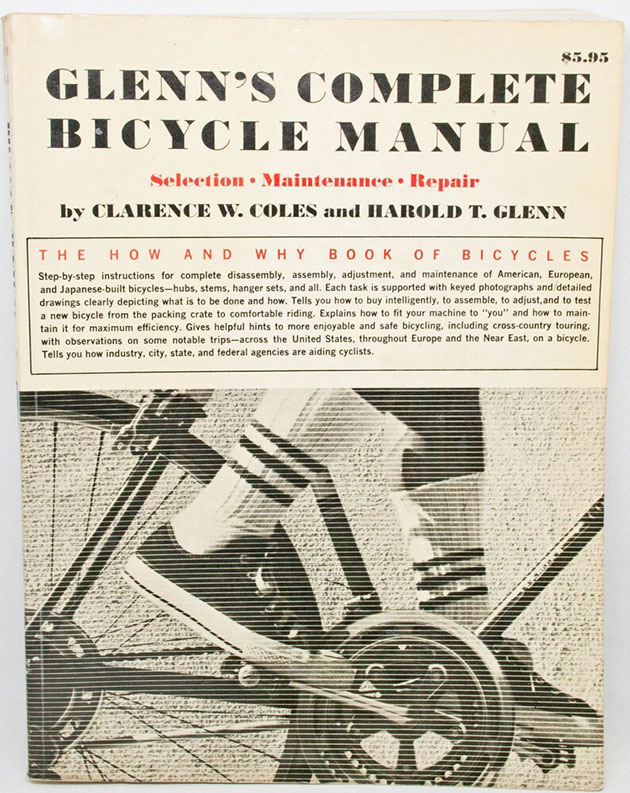

A Short History of Bike Tools
by John Neugent
Tech articles | Commentary articles |
The late John Neugent probably knew more about bicycle wheels than anyone else. Maybe more about bikes as well. He spent his life in the bike business, at every level. He owned Neugent Cycling, a firm devoted to delivering world-class equipment at the lowest possible price. —Chairman Bill

Author John Neugent

Marcus Aurelius' Meditations is available in both Kindle eBook & audiobook versions. To get your copy, just click on the Amazon link on the right.
John Neugent writes:
I remember my first days as a bike mechanic like they were 50 years ago. As I get older I find I can remember them better than I can remember last night. I bought whatever books I could on bicycle maintenance. None of the books had pictures or drawings so all instruction was in print. It was years before I got my hands on a Glenn’s Manual (a condensed version of the manual Schwinn produced for its dealers).
I guessed at which bicycle specific tools I would need and Park Tool hadn’t gotten into all of the smaller tools they have now. My choices were from Eldi, Var, Campy (for cone wrenches) and later Bicycle Research. At that time, tools mostly came without instruction. I do believe we quickly got a Park repair stand, but that could have been a few years later.

We were in the middle of a bike boom so adult bikes were good sellers, though only a few years earlier the majority of bikes sold were kids' bikes. Four or five years later I became a sales rep covering New England and many shops did not use repair stands. The two most common ways to work on a bike were either with it flipped over on its bars and saddle or hanging by ropes. One of my good customers who sold almost exclusively used bikes had been putting caged bottom bracket bearings (#66) backwards for years, so being a qualified mechanic was not difficult.
But, the bikes were heavy and sturdy. A ten-speed bike had a total of 10 speeds. There were no connecting links except on a single speed chain. You didn’t need them, you could use a hammer to push the link back together. There were no tensiometers or torque settings. It was the development of lighter and lighter bikes and parts that created a need for them. My first major repair was putting a new rim on a bent wheel. My partner had put a bike on a rear car rack and hit something that caused the rim to be bent. I figured it out by trial and error. Mostly by error. Raleigh bikes would come in with the ends of the spokes ground off in the rim channel. They used a thick cloth rim strip to keep the sharp points from causing a flat but the rim strip attracted water and rusted the spokes into place. Many bike shops didn’t like derailleur bikes but instead preferred internal gear hub bikes – the most prominent of which, in the US, were Sturmey-Archer. All Raleigh reps had to know how to disassemble and reassemble 3-speed hubs. It really was a different world. Many shops were bike and lawn mower stores.
Eventually, as the industry matured, better and better tools became available. I was a product manager for a distributor in the mid ’80s and Eric Hawkins from Park Tool showed up. He had just entered the company his father had started. His father had a large bike shop in the Minneapolis area and designed and manufactured the Schwinn bike stands. Eric has been instrumental in developing the wide range of tools that Park is famous for. I was going to get comments from Eric on this but by the time I emailed him, he was on a plane to Arizona. I gave him no lead time since I had to write this in a day but my hope is that I can get a good story on Park Tool at some point in the future.

Bicycle tools from the 1970s. The big VAR tool on the far right was an essential item for working on European bikes that came with steel cottered cranksets (though French firm Stronglight invented the cotterless crankset). This tool was used to drive out the crank cotter. Sometimes even this giant high-leverage tool couldn't do it and the cotter would have to be drilled out.
I’ve always been a tool guy but have to admit that I like to have them more than use them. You could write a book on bike tools to see how they sometimes preceded, but mostly followed, new technology but I want to leave with something in the history of bike evolution that is one of the most remarkable developments. Shimano introduced index shifting in the mid to early ’80s, which really did revolutionize drive trains. To do it they had to not only change the cogs on the cassette body (the spacing had to be perfect and have off ramps – so you could no longer build up custom gearing), they had to change the specifications of frames. Horizontal drop-outs, which were the norm at the time, allowed for rear triangles to be pretty sloppy and still work. Index shifting required vertical drop-outs which fixed the wheel in a specific position so the drive train geometry was accurate. The drop-out position was also key so the derailleur position was fixed. The result was not only vastly improved shifting (which none of us thought we needed – but mountain biking changed all of that by requiring shifting under load). The other major improvement was straight frames! Imagine that.
For many of us who rode real 10-speed bikes, the electric, disc brake, carbon trend makes us look back to the good old days. You don’t need a rocket ship to go to the local store.
John Neugent was one of the first to establish the making of quality hand-built wheels in Taiwan around the turn of the century. He now owns Neugent Cycling, a firm devoted to delivering world-class equipment at the lowest possible price.







